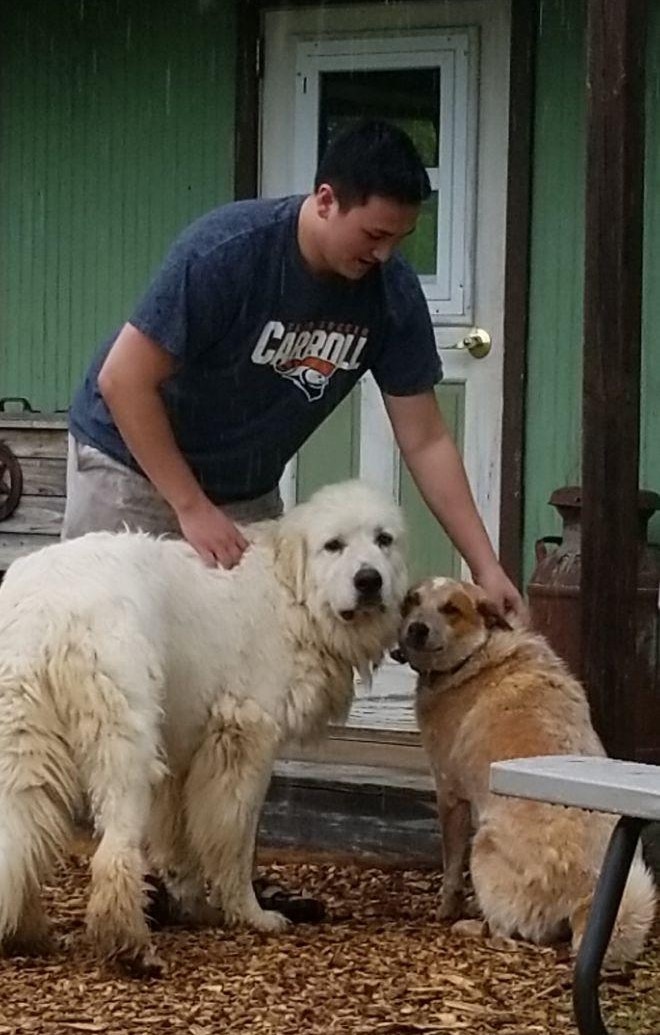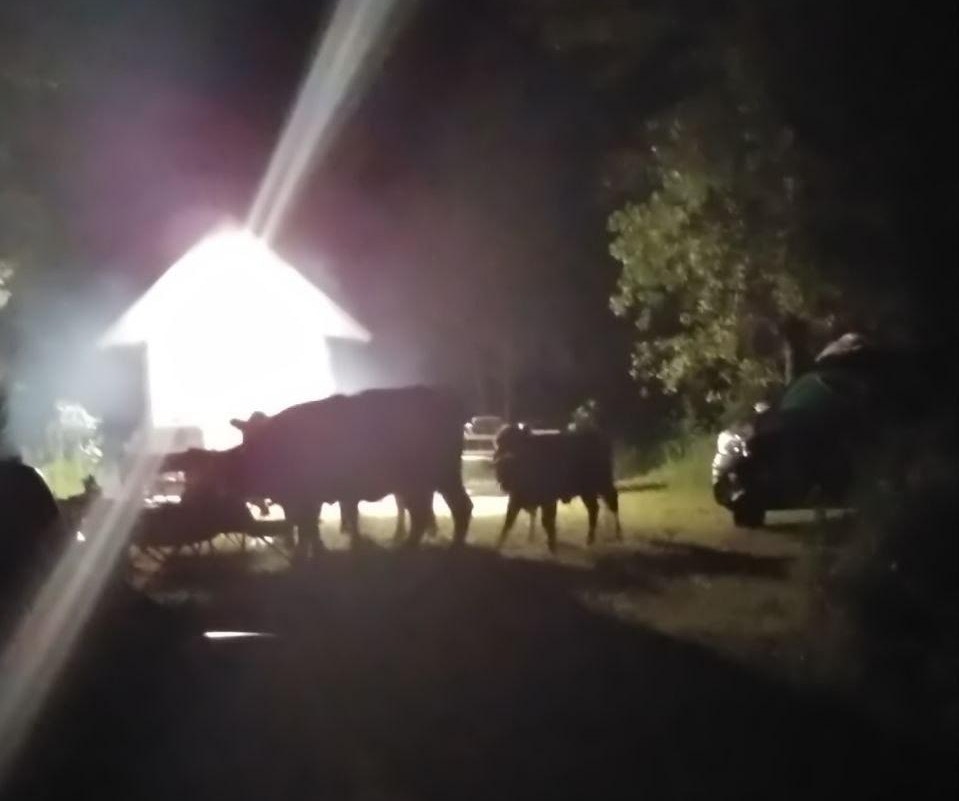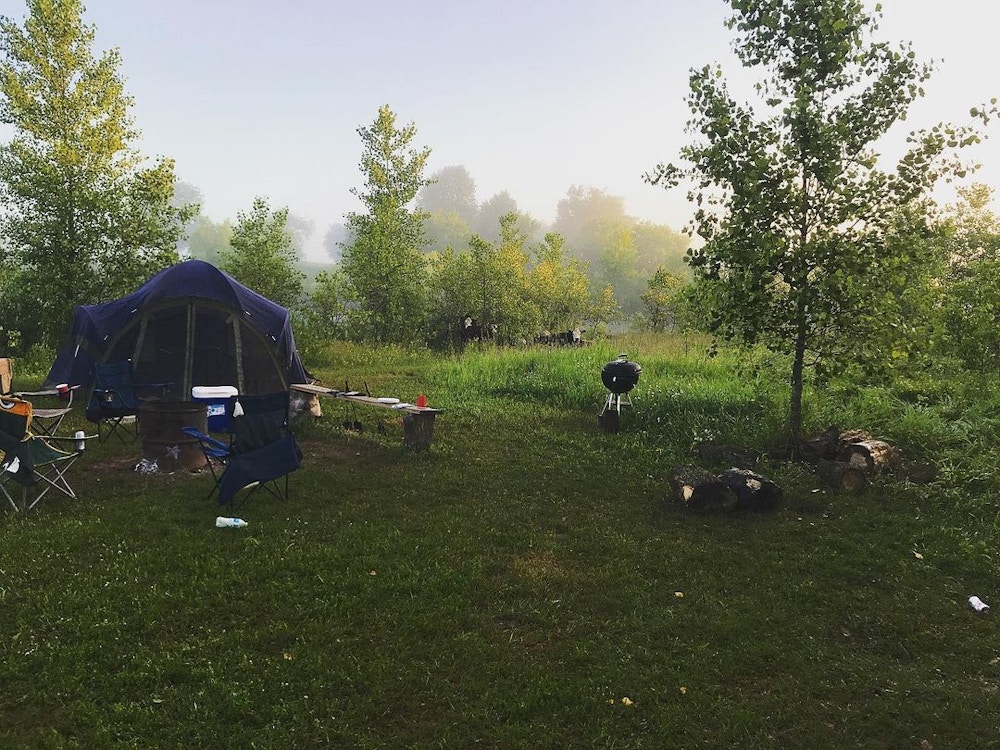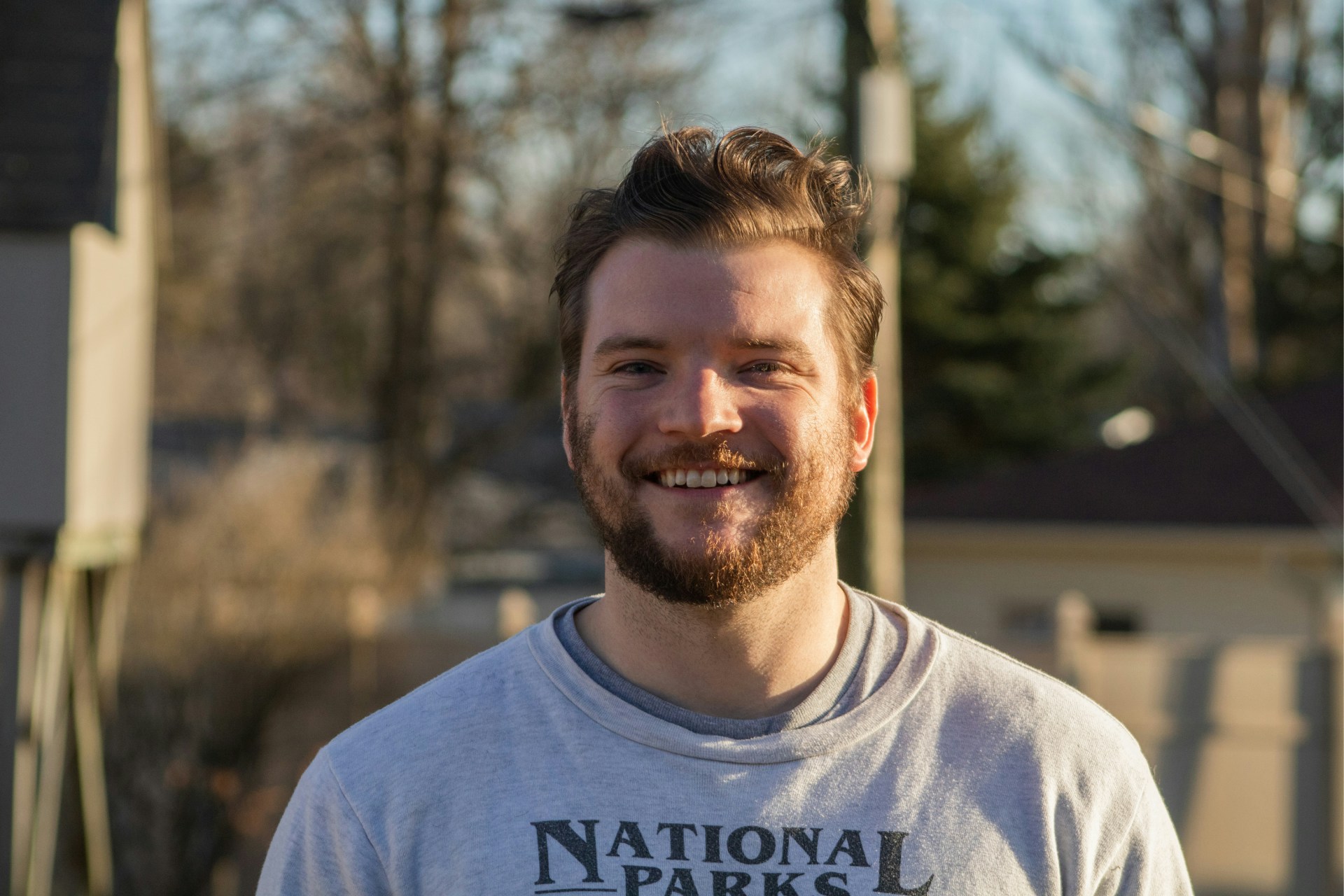Sep. 5, 2023
•23 min read
Stop me if you’ve heard this one before: an argument for regenerative farming practices while being chased by a herd of cows.
As part of my friends’ and my quest to find the most bizarre camping spots in Wisconsin, we booked a stay at The G Farm, advertised as “Camping with Cows.” A not-so-subtle harbinger of what was to come. It was late June 2020, so just about the only safeish way to hang out in the depths of COVID-19 was outdoors.
After being gifted various assorted beers and bourbon samples from our friend Andrew’s dad, Andrew, my brother Drake, and our friend Adam pile into my Jeep Cherokee on the Friday afternoon of our trip.
After some minor directional issues locating the farm, we realize we have arrived at our destination. While our host, Farmer Justin, is unseen, our informal host Otis arrives to greet us.
Otis—a Great Pyrenees well north of 100 pounds—jumps up and puts his paws and head into the driver-side window of the Jeep and then trots in front of the car. We assign Adam to jump out of the vehicle and lead Otis out of the way.
We make our way down a path to our secluded campsite, featuring a tiny home and a large pond. It begins to rain, so the four of us cramp into the small structure and crack open some beers. We plan to buy some food from Justin and get a bit rowdy once the rain subsides.
After an hour or so, the sun begins to glimmer through the clouds, and we scramble out of the ever-warming shelter. Andrew brings out a bottle of absinthe that he bought to “kick things up a notch.” We all take a shot—and gag on the hellish black licorice flavor. We make the group decision that this is the last of our absinthe drinking for the trip.
Otis rejoins us with his close associate on the farm, Baker, an Australian cattle dog. Otis, still wet from the rain, reveals more of his far-from-fearsome nature and proceeds to spend the next hour rotating between the four of us to get attention.
We make our way to the farm store to buy food for dinner. At Justin’s recommendation, we buy eight pork patties for the four of us. Andrew cooks up the pork patties (Andrew is a fantastic cook, whether sober or otherwise). We continue to give Otis the attention he seeks (and deserves). Andrew finishes cooking the food.
Otis continuously begs for our food. To Otis’s dismay, we send him away to eat our dinner in peace (sorry, Otis).
The night begins to fall, and we eat our meal—absolutely delicious. We immediately decide we will be visiting the farm store again the following day.
We laugh and joke around for the next few hours. We weren’t having the wild time that we envisioned, but it was altogether pleasant.
The gang started to perk up a little bit.
Suddenly what looks like a ghostly large white skull momentarily appears in the dark before apparating back into the night.
We question what in the world just visited us. We theorize that Otis had come back to join us; however, the head seemed to be too high off the ground even for a dog as considerable as the good boy Otis.
About 10 minutes later, our questions are answered.
The giant white head reappears, except this time, with its body joining along.
A large cow walks up to us, much to our surprise. We chuckle about this and are moderately confused.
Hell breaks loose, and our white-skulled interloper is joined by six other cows. They are already somewhat rowdy—running about in the brush near the site with oddly riotous energy.
At first, our concern is relatively low, but it starts to rise as the cows become increasingly manic. Their pace becomes more frenetic, galloping about in every which direction.
We fear that the cows—entranced in some sort of moonlight delirium—may accidentally trample us.
Admittedly, I know little about cow behavior, but I speculate that cows may not like water, so I call upon the crew to retreat to one of the piers on the pond. To our dismay and wonder, the cows follow us onto the pier, and their behavior becomes even more erratic.
Cows are falling off of the dock and swimming around. Pieces of the wooden pier are caving under their weighty bodies. It turns out that cows do, in fact, like water.
We’ve backed ourselves into quite the corner. We only have one choice to escape the bovine incursion. The four of us scramble onto the canoe—a scene that would have paired perfectly with Benny Hill music.
We watch as the cows’ chaos shows no signs of relenting. The cows are running completely amok, jumping off the pond's three piers, swimming to shore, and jumping off in some sort of unrelenting ritualistic cycle. After half an hour, we decide it is time to return to land, speculating that the cows may calm down if we enter our tent.
Once inside the tent, we hear the cows continuing their nocturnal mischief. We hear branches snapping, cows thudding into my car. Perhaps I’m imagining things, but it seems as if the cows are baying at the moon—perhaps in praise of Pagan gods of ancient societies now lost to the depths of history.
While I viewed cows as relatively benign animals, I am beginning to question this assessment as Adam is growing increasingly terrified of these blood-thirsty creatures. I float the idea of going outside and trying to shoo them away. Adam responds—in ever-increasing fear—that it may anger the cows. I begin to wonder if my worldview is wrong and cows are actually merciless predators.
I envision murderous cows with gnashing teeth.
To this point, we had avoided calling Justin, as we knew he had a young baby. We couldn’t imagine the toils of being a farmer, and having an infant isn’t an equation for much sleep, so we tried to avoid disturbing him.
Around 12:30 a.m., we cave and call Justin for help. He responds almost immediately and comes to the campsite and yips at the cows with casual efficiency. They quickly scatter and flee from the campsite. We figure that we are in the clear for the night and head back into our tent. I text my significant other that cows “are chasing us.”
Not 15 minutes later, we hear the now familiar rumble and commotion of the cows building. The cows are soon running with abandon around our tent. Over the sounds of mooing, I propose that I grab the vuvuzela from the trunk of my car (always come prepared). Adam responds—with his terror at a fever pitch—that I may anger the cows and cause them to crush us.
Nevertheless, I endeavor that fortune favors the bold and scuttle to the car to grab my weapon of choice. In my own mania, I blow into the horn with the full force of my lungs. As the vuvuzela booms in the night, the cows gradually abscond. Not as efficient as Justin, but it gets the job done.
I return to the tent yet again.
Thinking we had achieved peace from our oxen friends, not 10 minutes later, we hear cloven commotion building in the distance and the cows come careening back into our campsite. Adam warns us that the situation is far too dangerous for the tent and informs us that he will be sleeping in the Jeep. Drake follows to give him company for the night. Andrew and I sleep in the tent, surrendering to the knowledge that tonight, the cows have been overcome by some strange ethereal power and will be agents of chaos, despite any attempts otherwise.
Morning arrives, and we emerge from our restless slumbers to view the carnage of the rampage from the night before.
I check my phone, and my girlfriend has responded, “I don’t believe you,” to my text about being chased by cows. I shrug off the dismissal as it was a bizarre turn of events—for normal people, that is.
We theorize that the energy and recklessness we expected from ourselves the day before manifested in the cows in some sort of cosmic transfer.
Fortunately, the damage is mainly a large distribution of cow pies throughout the campsite. My car has mud stains from the cows but is otherwise unscathed. The most substantial damage was Justin’s piers, which now had a number of planks that were broken or altogether missing.
Justin comes down to the site to help us clean the cow poop.
He shows us a picture he took at 5 a.m. when the cows were still “just loving life.” Assuming it is inevitable for cow/human interaction on a working farm, we ask if this has ever happened before.
Justin replies that this has never happened before—we were the first. Makes sense.
As we reckon with the intensifying effects of climate change, our food supply is in grave danger. A vital tool for climate change resilience and reversal will be modernizing our food supply and production. The G Farm is the epitome of the sustainable practices we need to move towards a sustainable future.
After years of preparing taxes, Justin entered the world of family farming at a time when many small-scale farms struggled for survival. The rise of mega-farms has, in part, led to the overuse of antibiotics, pesticides, and insecticides. Additionally, factory farms use unsustainable amounts of water, and pollute our freshwaters. These farms also embrace animal cruelty as a fundamental component of their business model. As a result, factory farms have endangered the security of the global food supply and exacerbated climate change and climate vulnerability. Not to mention the litany of chronic diseases caused by the overuse of pesticides and insecticides
Family farming offers a unique opportunity to ensure food security, improve livelihoods, better manage natural resources, protect the environment, and achieve sustainable development, particularly in rural areas. Thanks to their wisdom and care for the earth, family farmers are the agents of change we need to achieve Zero Hunger, a more balanced and resilient planet, and the Sustainable Development Goals. - United Nations
Making Justin’s story even more unique and meaningful is the condition of his farmland before he purchased it. His farm was stripped of its topsoil and degraded of its nutrients. Rotating the livestock of his farm, he has continually restored the soil. From a firsthand experience, his cows, pigs, and fowl have much larger spaces to roam and live under much more humane conditions than on a typical farm.
“We are thrilled to partner with The G Farm to expand humane farming and increase farm animal welfare,” Larissa McKenna, FACT’s Humane Farming Program Director, The Country Today
Working to further reduce his carbon footprint and embrace sustainability, Justin has planted over 1,000 trees and perennial shrubs, installed a water pipeline, installed solar panels, and made many other investments to improve soil quality, the water table, air quality, and to sequester carbon.
The G Farm is an integral component of the local food supply as well. As part of its Community Supported Agriculture (CSA), the farm brings food production back into the community. CSA’s and farmers markets play an essential role in increasing access to healthy foods, strengthening local economies, increasing community connection, and reducing carbon emissions in local communities.
I also have to say that The G Farm’s meats are the highest quality I have ever eaten—it turns out that the sustainability and the ethical treatment of livestock have the added reward of tasting good.
We decide it’s time to take advantage of the paddle boat and canoe provided for campers. As the temperature climbs, we frolic on the pond, racing each other and fishing. After quite some time, we return to land.
Almost seconds after returning to land, we realize that we are sunburned and overheated from the water magnifying the impacts of the sun and heat and need to rest.
I watch Andrew pour Bloody Marys, which look to be about two-thirds vodka. We quickly realize that we are too hot to drink anything other than water. The sun is increasingly challenging to evade.
Due to the young age of the trees, most are too small to provide meaningful shade. We find the largest to sit under. However, the sun’s shifting position in the sky forces us to pick up our chairs and shift slightly to follow the creeping shade. We are transformed into a human sundial. The gang becomes increasingly listless.
Drake falls into a sleep on his chair. Andrew retreats into the now baking tiny house and falls asleep.
Adam and I take sanctuary from the sun in the tent. I fall into a half sleep, half delirium.
My head begins to pound from heat stress and dehydration taking their toll. While I am becoming increasingly delirious, I can tell that we need to take action or the group is going to be in much worse condition soon.
I awake Drake from his own delirium and explain to him that we need to go to the nearby gas station and get as many sports drinks as possible, or things could take a real turn south.
We stumble into the gas station as heat zombies and buy as many Gatorades as we can carry.
We return with four for each person and summon the group.
Each of us consumed one with a desperate fervor. The sun starts to fade beneath the horizon, and the temperature cools to less treacherous levels.
We continue to rest and drink liquids until we have returned to equilibrium. It is time to get more food from the farm store. This time we bought more brat patties, a pound of bacon, and a pound of beef patties (the irony is not lost upon us as we pass the cows from the night before).
We all begin to rehydrate ourselves by shotgunning beers. A drunken Andrew slings burgers, brat patties, and bacon on the grill—preparing one of the best meals of our lives.
Despite becoming shriveled husks during the Great Dehydration, we rally to have a drunken revelry long into the night—though we all have an unspoken disappointment that the cows do not visit us.
With a medium-grade hangover, the four of us packed our belongings and returned to society in the morning.
Camping With the Cows—with its strange prophecy fulfilled had come to an end. A hands-on lesson that if you are open to the bizarre, it will come find you.
There is beauty in the strange. And Camping With the Cows was certainly stranger than your average family camping trip. It was also a hands-on lesson that if you want to live in a future where we all can thrive, we should all support regenerative agriculture, sustainable practices, and locally sourced food.
And along the ride, find ways to be chased by herds of animals—the stories are just better that way.
More Articles by Alexander Nikolai
Jul. 18, 2023
•8 min read
Apr. 17, 2023
•12 min read
Feb. 7, 2023
•21 min read
About the author
Making Milwaukee weirder one day at a time.




